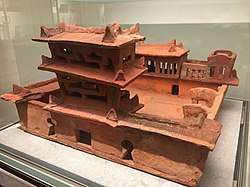Second Chinese domination of Vietnam
In Vietnam history, the second Chinese domination marks the period from the 1st century to 6th century AD when present-day northern Vietnam (Jiaozhi) was governed by various Chinese dynasties. This period began when Han dynasty reconquered Giao Chỉ (Jiaozhi) from the Trưng Sisters and ended in 544 AD when Lý Bí revolted against the Liang dynasty and established the Early Lý dynasty. This period lasted about 500 years.
Second Chinese domination of Vietnam Bắc thuộc lần thứ hai 北屬吝次二 | |||||||||
|---|---|---|---|---|---|---|---|---|---|
| 43–544 | |||||||||
 Map of the Liang dynasty in 502 | |||||||||
| Status | District of the Eastern Han dynasty-Eastern Wu-Jin dynasty-Liu Song dynasty-Southern Qi Dynasty-Liang dynasty | ||||||||
| Capital | Jiaozhi (Vietnamese: Giao Chỉ) | ||||||||
| Common languages | Old Chinese | ||||||||
| Government | Monarchy | ||||||||
| Emperor | |||||||||
• 43-57 | Emperor Guangwu of Han (First) | ||||||||
• 229-252 | Sun Quan of Eastern Wu | ||||||||
• 266-290 | Emperor Wu of Jin | ||||||||
• 420-422 | Emperor Wu of Liu Song | ||||||||
• 479-482 | Emperor Gao of Southern Qi | ||||||||
• 502–544 | Emperor Wu of Liang (Last) | ||||||||
| History | |||||||||
• End of Trung sisters' rebellion | 43 | ||||||||
| 222 | |||||||||
• Jin dynasty unified China | 265 | ||||||||
| 420 | |||||||||
| 479 | |||||||||
| 502 | |||||||||
| 544 | |||||||||
| Currency | cash coins | ||||||||
| |||||||||
| Today part of | Vietnam China | ||||||||
Seven Chinese dynasties

Eastern Han dynasty
The Trung sisters' revolt was one of the few brief interruptions during the Chinese domination of Vietnam which continued from 111 BC to 939 AD. After the defeat of the Trung sisters, the Eastern Han dynasty regained over the region in 43 AD.
During the rule of Emperor Ling (168-189) of the Eastern Han, Lý Tiến was the first native of Jiaozhi to be the inspector of Jiaozhou. Lý Tiến then petitioned the Han emperor to allow natives of Jiaozhi to be officers and mandarins in the Han court, but the emperor only accepted the ones who were awarded maocai (茂才) or xiaolian (孝廉) titles. Another native of Jiaozhi named Lý Cầm petitioned the throne and eventually the natives were allowed to take higher positions in other regions of the Han empire. For example, a Jiaozhi native named Trương Trọng was grand administrator of the Jincheng Commandery.
As the Eastern Han dynasty weakened, the Viceroy of Giao Chỉ Shi Xie briefly ruled Vietnam as an autonomous warlord from 206 to 210 AD before pledging royalty to Eastern Wu.[1]
Part of a series on the |
||||||||||||||||||||||||
|---|---|---|---|---|---|---|---|---|---|---|---|---|---|---|---|---|---|---|---|---|---|---|---|---|
| History of Vietnam | ||||||||||||||||||||||||
 | ||||||||||||||||||||||||
|
||||||||||||||||||||||||
|
Dominated
|
||||||||||||||||||||||||
|
||||||||||||||||||||||||
|
||||||||||||||||||||||||
|
||||||||||||||||||||||||
| Timeline | ||||||||||||||||||||||||
|
| ||||||||||||||||||||||||
Three Kingdoms eras
When the Eastern Han dynasty split into the Three Kingdoms in 220, Jiaozhi was under the control of the state of Wu. A rebel named Triệu Thị Trinh briefly challenged the Chinese rulers in 248, but was soon subdued.
Jin and Southern dynasties
Jiaozhi was under Jin China and the Southern and Northern Dynasties of Liu Song, Southern Qi and Liang. Chinese rule ended by 544, when Lý Nam Đế revolted.[2]
Uprisings
Local rebellions were organized by:
- Chu Đạt 156–160
- Lương Long 178–181
- Khu Liên 192, who founded the Champa kingdom.
- Triệu Chỉ 299–319
- Lương Thạch 319–323
- Lý Trường Nhân and Lý Thúc Hiến 468–485
References
Bibliography
- Taylor, Keith Weller. (1983). The Birth of Vietnam (illustrated, reprint ed.). University of California Press. ISBN 0520074173. Retrieved 7 August 2013.
- Vietnam
| Preceded by Trưng Sisters |
Dynasty of Vietnam 43–544 |
Succeeded by Anterior Lý Dynasty |
